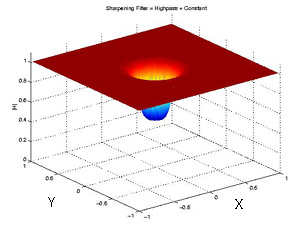|
|
| Sharpening Through Highpass Filters |
Brought to you by Team Phantom
Cruiser and the Power of Steam
|
|

|

| | Top: Original image. Bottom: Image filtered with
3rd order Butterworth sharpening filter, normalized cutoff frequency
.5, Gp = 1.1, Gs = .8 |

So if we can isolate the edges of an image, and we
know that the apparant sharpness of an image is dependant on the
strength of the edges, then we should be able to increase the
sharpness of an image by boosting the power in the edges, which means
boosting the power in the high frequencies. This is easily done
through a linear combination of the original image with the image
resulting from a highpass filter. And since all these operations are
linear, we can perform this addition prior to multiplying by the
filter rather than afterwards, and thereby simply incorporate it into
the filter.
If we call the transform of the original image A and a fully
attenuating highpass filter H, then the transform of the highpassed
image B(u,v) = A(u,v)*H(u,v). Therefore we can create any linear
combination C = aA + bB = aA + b(A*H) = A(a + bH) and therefore we
can create our sharpening filter H'(u,v) = (a + bH(u,v)). By
selecting a good ratio of a to b as well as choosing the
right cutoff frequency for the filter, we can therefore create natural
looking sharpening of the photo.
|



